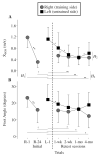Immediate and latent interlimb transfer of gait stability adaptation following repeated exposure to slips
- PMID: 18782713
- PMCID: PMC2614623
- DOI: 10.3200/JMBR.40.5.380-390
Immediate and latent interlimb transfer of gait stability adaptation following repeated exposure to slips
Abstract
The authors trained 21 participants by using blocked-and-mixed exposure to right-side slips and then caused them to slip unexpectedly on the untrained left side. Authors retested participants with a right slip and a left slip at 1 week, 2 weeks, 1 month, and 4 months. The authors found that preslip stability on the first untrained left slip improved and was significantly greater than that on the first right slip, which probably contributed to the reduction in incidence of falls from approximately 30% to approximately 10%. Postslip stability and base of support (BOS) slip velocity were similar to those on the first right slip and much lower than those on the last right slip. Increases in pre- and postslip stabilities and BOS slip velocity during the left slip led to reductions in backward balance loss (BLOB) from approximately 95% on initial left slip to approximately 60% and to approximately 25% on the 1st and 3rd retest sessions, respectively. In contrast, BLOB remained at a constant approximately 40% level on the right slip of the same retest sessions. The results indicate a partial immediate transfer and a possible latent transfer.
Figures




References
-
- Abeele S, Bock O. Transfer of sensorimotor adaptation between different movement categories. Experimental Brain Research. 2003;148:128–132. - PubMed
-
- Anstis S. Aftereffects from jogging. Experimental Brain Research. 1995;103:476–478. - PubMed
-
- Beling J, Wolfe GA, Allen KA, Boyle JM. Lower extremity preference during gross and fine motor skills performed in sitting and standing postures. Journal of Orthopaedic & Sports Physical Therapy. 1998;28:400–404. - PubMed
-
- Bhatt T, Pai Y-C. Long-Term Retention of Gait Stability Improvements. Journal of Neurophysiology. 2005;94:1971–1979. - PubMed
Publication types
MeSH terms
Grants and funding
LinkOut - more resources
Full Text Sources
Medical
